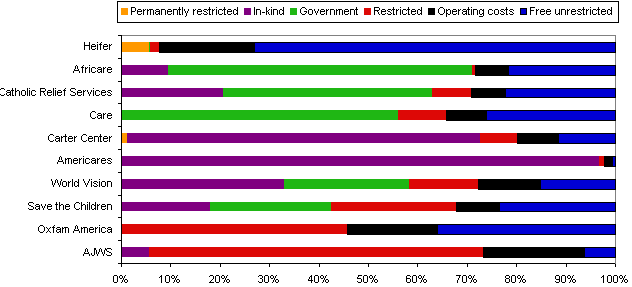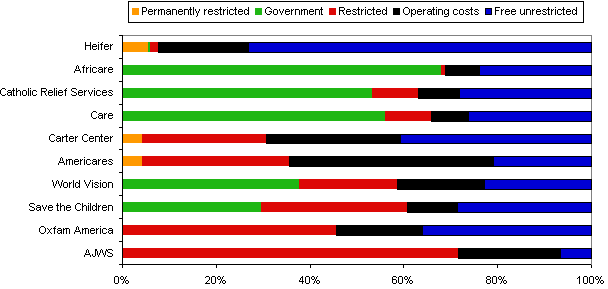Yesterday we discussed the difficult question of “room for more funding”: how can a donor determine how more funding will translate to more activities?
One common practice is to try to “force” your donation to fund the activities that attract you. Charities will formally honor your restriction by allocating your funds to the program in question.
But let’s look at an example of this in practice. Say you want to support Smile Train‘s core program of funding developing-world doctors, so you restrict your donation to that program. This restriction can’t change the fundamental underlying issue that we perceive: Smile Train has more funds available for this program than it has appropriate doctors.
So what happens? Smile Train might refuse your donation, but what seems more likely is that they’ll restrict it to the program you requested – freeing up an equivalent amount of unrestricted funding for their other activities (research, “provid[ing] materials on cleft lip and palate for free to anyone interested in this birth defect,” etc.) While “your” money pays for the core program, the effect of your donation is that more of the other programs get funded.
In other words, the idea that your fund is “restricted” to the core program is a close parallel to the illusion that it is “restricted” to non-overhead costs.
Could there be cases in which a restriction “works”?
We think so. It seems to us that the necessary conditions are that
- The program you restrict your donation to has no unrestricted funding allocated to it – so your donation can’t “replace” such funding, and the charity must react to your donation by increasing that program’s budget. (More precisely, if the amount of unrestricted funding allocated to the program exceeds the size of your donation, your donation will merely “crowd out” unrestricted funding; if the amount of unrestricted funding is less than the size of your donation, your donation will have to increase the program’s budget size by such amount. Thus, the larger your donation is, the more likely it is to be able to actually affect an organization’s priorities.)
- The program you restrict your donation to can productively use more funds (not a given).
How often do the conditions above actually hold? We aren’t sure, and have been trying to get a clearer picture. We have been working on analyzing major international charities’ restricted/unrestricted funding situations, and so far have produced the following using their most recent audited financial statements (generally from 2008):

The purple, orange, green, and red all represent revenues that are “restricted” in some way, and the black represents the fundraising and administrative costs that presumably have to be covered with unrestricted revenues. The blue is calculated as unrestricted revenue minus “operating costs” – i.e., revenue that is likely free to be used at the charity’s discretion.
Since several of these lines are distorted by large (and possibly concerning) amounts of in-kind donations (i.e., gifts of goods rather than cash), we reproduce the charts with in-kind donations excluded to get a clearer picture of the restrictions on cash revenue:

More investigation is needed. In the meantime, we note that
- We would guess that cases fitting the conditions for “meaningful restricted funding” are rare – i.e., when you give to a multiprogram organization, your donation usually will expand what they want to expand, regardless of how you restrict it.
- We have a general aversion to restricting donations. It seems like “micromanaging” an organization in this way is asking for trouble: the charity may avoid your intentions using technicalities or spend the “extra money” allocated to a program badly, and in any case, you are creating an extra headache for the charity.
Thus, our current rule of thumb is to find an organization whose existing priorities you are comfortable with – and give unrestricted.
Further challenges raised by this rule of thumb
The above rule of thumb can be tricky to apply, because you have to (a) identify what counts as an “organization” (b) identify the organization’s priorities, which (as we previously discussed) can be very difficult. We’ll briefly discuss (a) here, and discuss (b) in future posts.
Cases where it’s not obvious what counts as an “organization”:
- One of our top charities, the Stop Tuberculosis Partnership, takes donations through the UN Foundation, and requests that they be earmarked for the “Stop Tuberculosis Partnership.” Should such gifts be thought of as restricted gifts to the UN Foundation or as unrestricted gifts to Stop TB?
- A recent debate on Tactical Philanthropy brings up a cancer research program within a university. Can/should one meaningfully earmark a donation to this program as opposed to the university as a whole?
To us, the ultimate test is “Do the people who exercise discretion over the pool of funds including my money have priorities that I’m comfortable with?” We perceive the UN Foundation as a pass-through that does not exercise discretion over the Stop Tuberculosis Partnership budget. We would guess that the university situation is somewhere in the middle, with different parties exercising different amounts of discretion, but that to a large extent, the cancer research program is responsible for raising its own funding rather than reliant on the discretion of the university. Both of these cases contrast with something like earmarking a CARE donation for a particular country – that donation is going to go into the pool of funds allocated with discretion by the central office.
Future posts will discuss some ideas for tackling the more difficult part (b): getting a handle on an organization’s true priorities, even as it tries to assure you that your funds will pay for the program that appeals to you most.

Comments
This is a very interesting post on an important topic. There is only one thing that I disagree with. It seems to me that the first of your necessary conditions is too strong (and thus not necessary):
This assumes that the organisation will always shuffle things around so as to best fulfil its own priorities. I doubt that this is true. Surely there are at least some charities that run a couple of programs and will spend more on the one that donors earmark more funds for (even when they could undo the donor preference with unrestricted funds). Indeed, I think this would be quite common (maybe 50% of charities?). You couldn’t rely on it, but I’m sure it does happen.
It could take several forms: not changing any unrestricted funding in response to the donation (for a 100% effect), or moving some unrestricted funding but not enough to cancel the effect (100% effect).
Toby,
Do you have any firsthand knowledge of such charities? My nonprofit experience, mostly limited to the arts, says that organizations will allocate money according to their own priorities unless restrictions force them to do otherwise.
And this is not a bad thing. If you trust a charity to spend your money well, you should trust them to allocate it well. If you don’t trust them to allocate the money in the right way, then their mission is probably not a good fit for your interest as a private donor.
There are exceptions to this rule, but they’re rare and generally apply only to foundations.
Ian,
No I don’t have any such firsthand knowledge. However I would be shocked if this didn’t happen at all (i.e. if charities were all perfectly efficient at reorganising their funding according to their own priorities and paid no attention to what donors wanted fund unless forced to by lack of moveable funds). The real question is how close charities are to this model as opposed to the model of not moving their flexible money around to counter donor-choice.
Fascinating post Holden. I love how you helped take the Brest/Shoemaker debate out of theory and applied it to actual budgets at actual charities. Well done!
While Toby could of course be correct in theory, I would bet that what he is describing is very rare for small donors/large charities.
There simply isn’t any incentive for charities to do what he’s describing. Why spend more money on more popular activities? Few charities even disclose how much money they spend on each activity (even The Carter Center does not despite disclosing just about everything else). Certainly, I would guess that it’s extraordinarily rare for donors to ask about a complete budget breakdown by program and be more likely to support a charity if it’s spending slightly more on their favorite activity. (More common for them to take the fallacious “shortcut” described here.)
As long as a charity spends enough on an activity to credibly advertise it, it reaps 99-100% of the benefit from a fundraising perspective.
By contrast, when a donation is large enough to be associated with its own specific “project,” that could easily end up costing the charity extra.
What if a charity agreed, as a matter of policy, that it would spend its unrestricted donations in proportion to the amount of restricted donations that its programs received?
For example, say other donors give the charity $200 in donations restricted to program A and $200 in donations restricted to program B. If I do not donate, then each program gets $200 plus 1/2 of the unrestricted contributions. If I give $100 restricted to program A, then program A will get $300 in restricted contributions, plus 60% of the unrestricted contributions, so the benefit to program A is that it received my $100 plus an additional 10% of the unrestricted contributions.
Stephen – thanks for the comment. It certainly seems conceptually possible. I’ve never seen a policy like this in practice.
Comments are closed.